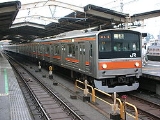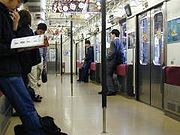
205 series
Encyclopedia
The is a commuter electric multiple unit
train type introduced in 1985 by Japanese National Railways
(JNR), and currently operated by East Japan Railway Company
(JR East) and West Japan Railway Company
(JR West).

livery. Both were created by the late Shotaro Ishinomori
, a native of Ishinomaki, Miyagi
; Ishinomaki Station
is the terminus of the Senseki Line.
in 2011, where they will operate as 3-car 6000 series sets.
Electric multiple unit
An electric multiple unit or EMU is a multiple unit train consisting of self-propelled carriages, using electricity as the motive power. An EMU requires no separate locomotive, as electric traction motors are incorporated within one or a number of the carriages...
train type introduced in 1985 by Japanese National Railways
Japanese National Railways
, abbreviated or "JNR", was the national railway network of Japan from 1949 to 1987.-History:The term Kokuyū Tetsudō "state-owned railway" originally referred to a network of railway lines operated by nationalized companies under the control of the Railway Institute following the nationalization...
(JNR), and currently operated by East Japan Railway Company
East Japan Railway Company
is the largest passenger railway company in the world and one of the seven Japan Railways Group companies. The company name is officially abbreviated as JR East in English, and as in Japanese. The company's headquarters are in Yoyogi, Shibuya, Tokyo....
(JR East) and West Japan Railway Company
West Japan Railway Company
, also referred to as , is one of the Japan Railways Group companies and operates in western Honshū. It has its headquarters in Kita-ku, Osaka.-History:...
(JR West).
Lines on which 205 series trains operate
(in alphabetical order)- Hachikō LineHachiko LineThe is a 92.0 km regional railway line owned and operated by East Japan Railway Company . It is located within Tokyo, Saitama, and Gunma Prefectures in Japan. Its endpoints are Hachiōji Station in Hachiōji, Tokyo and Kuragano Station in Takasaki, Gunma Prefecture.-Services:Komagawa Station in...
: 4-car 205-3000 series sets (x5) (from 2003) (former 205-0 sets modified by JR-East to form shorter trainsets for use in outer suburban services) (have passenger-operated door controls) - Hanwa LineHanwa LineThe is one of commuter rail lines and services in Osaka-Kobe-Kyoto Metropolitan Area, owned and operated by West Japan Railway Company. The line runs between Osaka and Wakayama, Japan and has a 1.7-kilometre branchline in Osaka suburb....
: 4-car 205-1000 (built by JR-West) series sets (from 1988) - Kawagoe LineKawagoe LineThe is a railway line operated by East Japan Railway Company , which connects the cities of Saitama, Kawagoe, and Hidaka in Saitama Prefecture, Japan...
: 4-car 205-3000 series sets (x5) (from 2003) (former 205-0 sets modified by JR-East to form shorter trainsets for use in outer suburban services) (have passenger-operated door controls) / 10-car 205-0 series sets (from 1989) - Keiyō LineKeiyo LineThe is a railway line connecting Tokyo and Chiba, Japan, running mainly along the edge of Tokyo Bay. It is operated by the East Japan Railway Company .It provides the main rail access to the Tokyo Disney Resort and the Makuhari Messe exhibition center...
: 10-car 205-0 series sets (from 1990) - Musashino LineMusashino LineThe is a railway line operated by the East Japan Railway Company . It links Tsurumi Station in Yokohama with Nishi-Funabashi Station in Chiba Prefecture, forming a 100.6 km unclosed loop around central Tokyo...
: 8-car 205-0 series sets (some sets are powered by 205-5000 intermediate motor car units modified from 205-0 to utilize AC motor traction system) - Nambu LineNambu LineThe is a Japanese railway line which connects Tachikawa Station in Tachikawa, Tokyo and Kawasaki Station in Kawasaki, Kanagawa Prefecture. For most of its length, it parallels the Tama River, the natural border between Tokyo and Kanagawa prefectures. It is part of the East Japan Railway Company ...
: 6-car 205-0 (x31) (including 4 sets with 205-1200 driving trailers which were converted from 205-0 intermediate trailers by JR-East) - Nambu Branch LineNambu LineThe is a Japanese railway line which connects Tachikawa Station in Tachikawa, Tokyo and Kawasaki Station in Kawasaki, Kanagawa Prefecture. For most of its length, it parallels the Tama River, the natural border between Tokyo and Kanagawa prefectures. It is part of the East Japan Railway Company ...
: 2-car 205-1000 series sets (x2) (from 2002) (former 205-0 sets modified by JR-East to form shorter trainsets for use in outer suburban services) - Sagami Line: 4-car 205-500 series sets (x13) (from 1991) (built by JR-East for use in outer suburban services)
- Saikyō LineSaikyo LineThe is a railway line between Ōsaki Station in Shinagawa, Tokyo, and Ōmiya Station in Saitama Prefecture, Japan. It is a part of the East Japan Railway Company network...
: 10-car 205-0 series sets (from 1989) (through service to Rinkai LineRinkai LineThe is a railway line located in Tokyo, Japan. It is the only line operated by the third-sector company Tokyo Waterfront Area Rapid Transit. It connects central Tokyo to the artificial islands of Aomi and Odaiba...
) - Senseki LineSenseki LineThe is a rail line in Miyagi Prefecture, Japan. Part of the East Japan Railway Company system, it runs from Aoba-dōri Station in Sendai to Ishinomaki Station in Ishinomaki, and provides access to the central coast areas of Miyagi Prefecture, significantly the Matsushima area...
: 4-car 205-3100 series sets (from 2004) (former 205-0 sets modified by JR-East to form shorter trainsets for use in outer suburban services) (have passenger-operated door controls, toilets, and passenger seating which can be arranged in either 'transverse' or 'longitudinal') - TokaidoTokaido Main LineThe is the busiest trunk line of the Japan Railways Group , connecting Tōkyō and Kōbe stations. It is long, not counting its many freight feeder lines around the major cities...
Local Service (KyotoJR Kyoto LineThe is the common name of a portion of the Tōkaidō Main Line, between Kyoto Station and Osaka Station. The line is one of commuter rail lines and services in Osaka-Kobe-Kyoto Metropolitan Area, owned and operated by West Japan Railway Company ....
, KobeJR Kobe LineThe is the nickname of portions of the Tōkaidō Main Line and the Sanyō Main Line, between Osaka Station in Osaka, Osaka Prefecture and Himeji Station in Himeji, Hyōgo Prefecture...
lines): 7-car 205-0 series sets (from 2011) (formerly operated on JR-West's Hanwa Line forming 6- and 8-car sets) - Tsurumi LineTsurumi LineThe is a railway line operated by East Japan Railway Company in Kanagawa Prefecture, Japan. It provides passenger service along a 7 km between Tsurumi Station in Tsurumi-ku, Yokohama and Ōgimachi Station in Kawasaki-ku, Kawasaki. Branches bring the total length of track to 9.7 km. The...
: 3-car 205-1100 series sets (from 2003) (former 205-0 sets modified by JR-East to form shorter trainsets for use in outer suburban services) - Yokohama Line: 8-car 205-0 series sets (x27) (from 1988) (initially 7-car sets)
Lines on which 205 series trains previously operated

- Yamanote LineYamanote LineThe is commuter rail loop line in Tokyo, Japan, operated by East Japan Railway Company . It is one of Tokyo's busiest and most important lines, connecting most of Tokyo's major stations and urban centres, including the Yūrakuchō/Ginza area, Shibuya, Shinjuku, and Ikebukuro, with all but two of its...
: 11-car 205-0 series sets (1985 - 2005) (initially 10-car sets) - Chūō-Sōbu LineChuo-Sobu LineThe is a railway line located in Tokyo and Chiba Prefecture, Japan. Part of the East Japan Railway Company network, it runs on separate tracks along the right-of-way of the Chūō Main Line and Sōbu Main Line , providing service between Mitaka Station in the cities of Mitaka and Musashino and...
: 10-car 205-0 series sets (1989 - 2001) - Keihin-Tōhoku LineKeihin-Tohoku LineThe , is a railway line in Japan which connects the cities of Saitama, Kawaguchi, Tokyo, Kawasaki, and Yokohama. It is part of the East Japan Railway Company network. The line's name is derived from the characters for , and the...
: 10-car 205-0 series sets (1989 - 1996) - TokaidoTokaido Main LineThe is the busiest trunk line of the Japan Railways Group , connecting Tōkyō and Kōbe stations. It is long, not counting its many freight feeder lines around the major cities...
-Sanyō Local Service (Biwako, KyotoJR Kyoto LineThe is the common name of a portion of the Tōkaidō Main Line, between Kyoto Station and Osaka Station. The line is one of commuter rail lines and services in Osaka-Kobe-Kyoto Metropolitan Area, owned and operated by West Japan Railway Company ....
, KobeJR Kobe LineThe is the nickname of portions of the Tōkaidō Main Line and the Sanyō Main Line, between Osaka Station in Osaka, Osaka Prefecture and Himeji Station in Himeji, Hyōgo Prefecture...
, Takarazuka lines): 7-car 205-0 series sets (1986 - 2006) - Hanwa LineHanwa LineThe is one of commuter rail lines and services in Osaka-Kobe-Kyoto Metropolitan Area, owned and operated by West Japan Railway Company. The line runs between Osaka and Wakayama, Japan and has a 1.7-kilometre branchline in Osaka suburb....
: 6- and 8-car 205-0 series sets (2006 - 2010) (formerly operated on JR-West's Tokaido-Sanyo Local Service forming 7-car sets)
Design variants
There have been many variations of the design of the 205 series trains. Below is a list of photos for various 205 series designs as indicated by the liveries of the lines they serve.Senseki Line "Mangattan Liner" trains
A Senseki Line 205-3100 series "Mangattan Liner" trainset is decorated with images of the cartoon character Robocon from the 1970s anime Ganbare!! Robocon, while another ("Mangattan Liner II") has Kamen RiderKamen Rider
, is a weekly science fiction story created by Japanese manga artist Shotaro Ishinomori. It debuted as a tokusatsu television series on April 3, 1971 and ran until February 10, 1973, airing on the Mainichi Broadcasting System and NET TV . A manga adaptation was also featured in Shōnen Magazine...
livery. Both were created by the late Shotaro Ishinomori
Shotaro Ishinomori
was a Japanese manga artist who became an influential figure in manga, anime, and tokusatsu, creating several immensely popular long-running series such as Cyborg 009 and Himitsu Sentai Goranger, what would go on to become part of the Super Sentai series, and the Kamen Rider Series...
, a native of Ishinomaki, Miyagi
Ishinomaki, Miyagi
is a city located in Miyagi Prefecture, Japan.As of January 1, 2010, the city had an estimated population of 164,294 and a population density of 295.83 persons per km²...
; Ishinomaki Station
Ishinomaki Station
is a JR East railway station located in Ishinomaki, Miyagi, Japan. The station and surrounding streets known as Manga Road are adorned with statues of characters created by Shotaro Ishinomori...
is the terminus of the Senseki Line.
Private operators
A number of former 205 series trains were sold to the Fuji KyukoFuji Kyuko
, commonly abbreviated as Fujikyū, is a passenger transportation company headquartered in Fujiyoshida, Yamanashi, Japan.The company operates a railway line and regional and long-distance bus routes. The company also operates the Fuji-Q Highland amusement park.The Gakunan Railway is a consolidated...
in 2011, where they will operate as 3-car 6000 series sets.

